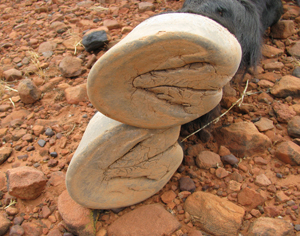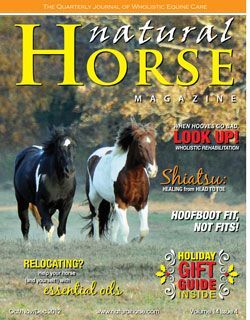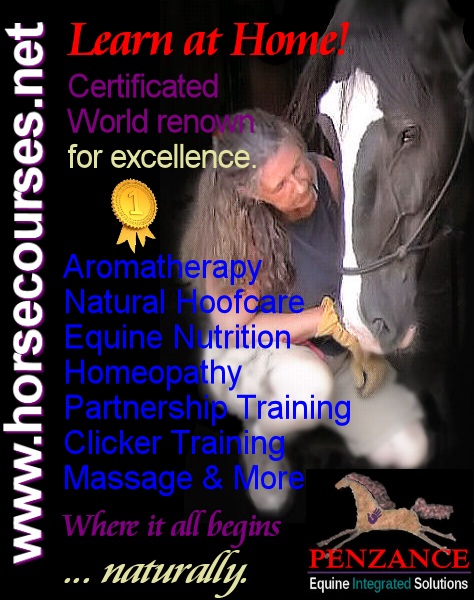Natural Foot Model: Not Perfect?
By Elaine PascoAn Australian study recommends that the hoof used as the model of health for natural hoofcare should be reconsidered.
The short-walled hoof of feral desert horses is often used as the model for natural hoofcare in domestic horses.
March 27, 2012—Nature, not the farrier, shapes the feet of feral horses. A school of “natural” hoofcare holds these feet up as a model of health, and followers try to replicate the shape in domestic horses. But the model may not be all it’s cracked up to be, says a report from Australia.The report summarizes 14 studies backed by Australia’s Rural Industries Research and Development Corporation, a government agency. Researchers looked at genetics, travel profiles, nutrition, foot shape and structure, and foot health in a large number of feral horses from different environments. Here are three key findings:
There’s more than one model. Researchers who looked at feral horses from six environments identified six different foot models—because environment changes foot shape. The distance feral horses travel to find food and water and the type of surface they travel on determine hoof structure. The short-walled hoof usually considered the natural model is a desert foot, shaped by long-distance travel over hard, dry ground. On softer footing, with food and water close at hand, hoof growth exceeds wear and feet grow long and flared.
Change may be good or bad. The fact that the horse’s feet respond to the environment doesn’t mean that they always adapt in ways that help the horse. Long, flared feet are prone to cracking and injury, and some desert feet show excessive wear.
Natural doesn’t mean healthy. The researchers discovered high rates of foot problems in the feral horses. A study that examined the left forefeet of 100 horses found 377 significant abnormalities; only three feet had no problems. A combination of high travel and hard ground was linked to more serious foot problems.
Although feral horse feet often appear healthy and at first glance seem an ideal model for domestic horses, the researchers say that the model should be reconsidered. “Best practice in hoof care should evolve from passed-on knowledge, new research, clinical practice and practice review. Knowledge of wild horse and feral horse feet provides useful supportive information, but a feral horse foot model should not form the basis for the foot care of the domestic horse,” the report concludes. You can download the full report online at www.rirdc.gov.au.
This article originally appeared in the April 2012 issue of Practical Horseman magazine.
The “Wild Horse Hoof” … yes, still held as *the* hoof by which to model our hoofcare.
However … to my professional colleagues I ask — what domestic horse, in today’s world, eats nothing but live, fresh forage, no artificial drugs or chemicals, travels upwards of 20 – 30 miles a day over 200 square acres of varied terrain, lives in family groups within a herd of hundreds and has NO human interference?
I’d venture to say that each one of you answers the same – NONE.
Neither do I.
One cannot disconnect the hooves from the horse. They are forever connected and one affects the other without question. That means that whatever affects the horse’s mind affects the hooves. Whatever affects the horse’s blood affects the hooves. Whatever the horse does, affects the hooves. The environment, the diet, the stress levels, the discipline, even the proficiency and expertise of the rider on the horse’s back affects the hooves.
While the wild horse model hoof appears to be the ‘perfect’ hoof, as stated in the article most are far from perfect. Compare the hooves of horses that roam dry, arid desert-land to those who live on the shore lines or in the moors. You’ll not find very pretty hooves in the moors or standing in seaweed laden sand. Hard, dry, parched sands/dirt do not cause the same wear and tear on the hooves as soft, damp sands and grasses.
As much as the terrain affects the growth and wear of the hooves of domestic horses, varying seasons do as well and we adjust our care schedules as such.
Ferals do not have processed, specialized grains delivered to them daily in large quart quantities nor do they generally have flakes of cured, dried hay supplied to them. They eat what nature provides.
Their bodies adjust accordingly.
The hooves adjust accordingly.
So while we professional hoofcare providers, farriers and trimmers, argue about the merits of this method of trimming or that style shoe, it would behoove us to realize that the horse, himself, will dictate, according to his own lifestyle, what his hooves need and what ‘model’ he will represent.
I guarantee you that his ‘model’ will be — totally individual according to each hoof and how his lifestyle dictates.
No, there is no ‘perfect hoof model’. What is good, what is ‘perfect’ is that which is best for the individual hoof-in-hand on the individual horse-in-hand.












Sarah Block: OMG! Are you serious?! Please get your facts right before posting random comments! There may be a lot of things that “evolved in the US”, but todays feral horses are not one of them!
I feel like this article misses a major point in natural hoof trimming. And that is that horse owners should be striving to create a more natural lifestyle for their horses. Removing lush grass and over processed feeds from the diet while also encouraging more movement. These things make a big difference in the hooves of horses.
As far as the varying health of horses in other locations and climates, I would say again that horses in the wetter climates with chipped and broken hooves aren’t necessarily thriving there. Just because wild horses have made an area like that their home and are making due doesn’t mean it is the ideal lifestyle for them. If it were, the mentioned issues probably wouldn’t be present.
The perfect hoof is indeed the hoof that functions and feels best for each individual equine……however a model must be used as a general guide and I believe the North American wild horse hoof serves that purpose well….unshod, adequate miles for appropriate wear, a forage diet without excess sugars or concentrated unnatural feeds – diet and exercise
allowing the best healthy hoof to be a reflection of whole horse heath……
There is a “model” for the domestic horse, the sport horse and it has been defined, not by traditionnal farriery but by a farrier that stated thinking hoof instead of shoe, and most of all foot within the hoof. His name is KC Lapierre.
Also, it Just depends on what you put under the word “model”. Just stating that every horse has its own individual model is really being complacent with simplicity. This not going to take the industry of equine foot care anywhere. Tissues grows owing to influences from the inside but also from the outside. Knowing in real details what tissues constitute the foot of the horse, how this tissue grows and what influence their growth is a part of the work required to define a model. Another well know law states that Force = Mass x Acceleration and to be taken into acount for our domestic horse ; that law in itself discard the feral hoof as a model for our domestic horses.
but why study the horses in Australia when they did not evolve in Australia!!!! the only wild horses studied as a model should the the ones in the US because that is where they evolved. . . the terrain is too harsh, too dry in Australia. . . just because they are now “wild” does not mean they are the ideal model. Horses in the US evolved here, left and were reintroduced to their ancient homeland, which is why they do so well. Just an example of how the environment has to be right.
I think the point made here is that while your horse is transitioning from shod to barefoot you should take advantage of how the hoof develops, and trim just to keep it ‘tidy’. It will all depend on how much work, and where, your horse is doing. My two have very different workloads; the one that hacks the most has developed the smaller, harder hoof, while the other has a more flared foot. I hope this helps! For interest the first horse was diagnosed with navicular and going barefoot saved his life, he now regularly hacks out 30 miles a week.